Urbino, what to see: the 10 places to visit in the city of the Renaissance
Urbino, a city located in the hills of the Marche region, has gained international fame for its extraordinary artistic and cultural heritage. However, its notoriety is not only due to its artistic riches, but also to its history and the key role it played in the Italian cultural landscape of the Renaissance. In the heart of Urbino is the Ducal Palace, a monument of great grandeur and beauty, now home to the Galleria Nazionale delle Marche. Commissioned by Federico da Montefeltro in the 15th century, this palace represents an icon of the Italian Renaissance. Its architecture, enhanced by elegant courtyards and sumptuous rooms, reflects the power and sophistication of the Montefeltro family. One of the additional reasons for Urbino’s fame is its association with the famous painter, Raphael Sanzio. Born in this city in 1483, Raphael grew up in an environment rich in culture and art, influenced by the patronage of the powerful Montefeltro family, particularly Duke Federico da Montefeltro. The city played a crucial role in the artistic training of Raphael, who received a high-level education in the atelier of his father, Giovanni Santi, also a renowned painter.
The city is a treasure trove of artistic and architectural treasures. Its historic center, declared aUNESCO World Heritage Site in 1998, is a labyrinth of narrow streets, Renaissance palaces and churches. In addition, it was an important cultural center during the Renaissance, attracting prominent artists, men of letters and philosophers of the time. People such as Baldassarre Castiglione, author of “Il Cortegiano,” and Leon Battista Alberti, renowned architect and art theorist, contributed to Urbino’s renown as a center of thought and creativity. Today, the city continues to live and breathe its rich historical and artistic legacy while remaining an enchanting destination for those who wish to immerse themselves in the art, history and culture of Renaissance Italy. So here is what to see in Urbino, what are the ten places to visit if you are in this city.
1. Ducal Palace
The Ducal Palace, now home to the Galleria Nazionale delle Marche, is a magnificent example of Renaissance art, blending harmoniously with its surroundings to create what Baldassarre Castiglione called a “City in the form of a Palace.” Commissioned by Federico da Montefeltro, Duke of Urbino, the palace housed an extraordinary art collection, now divided between its rooms and the Uffizi Gallery in Florence. Federico, a Renaissance prince, embodied a model of the enlightened prince: skilled military strategist, patron of the arts, astute politician, refined collector and humanist scholar with a passion for geometry and mathematics. Under his rule, Urbino became a cultural beacon of the Italian Renaissance. The wing facing the Piazza Rinascimento, with its elegant façade adorned with mullioned windows with two lights, houses the palace’s only frescoed hall. The apartments and the Ballroom bear witness to the magnificence of the period, while the Courtyard of Honor celebrates Frederick’s glory as a condottiere and enlightened prince. The palace’s library, originally rich in precious illuminated manuscripts, is now part of the Vatican Library’s collection.
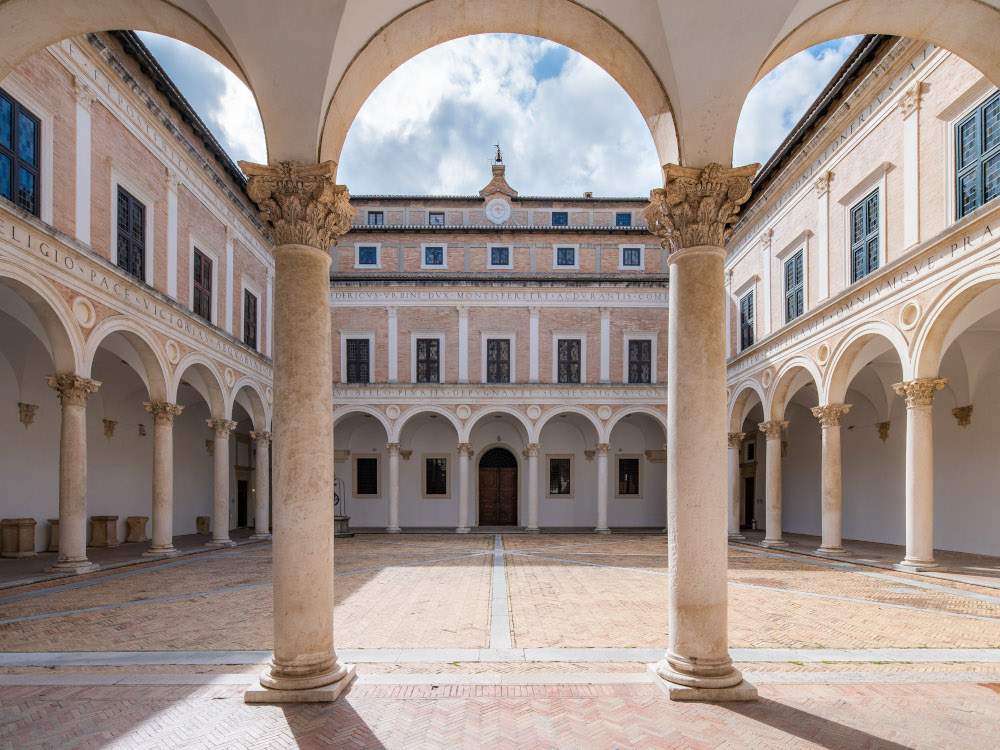
2. National Gallery of the Marches
The Galleria Nazionale delle Marche presents its valuable collections in the sumptuous Ducal Palace in Urbino, commissioned by Federico da Montefeltro. Today, the palace houses 17th-century paintings, graphics and ceramics. The Hall of the King of England, with its gilded stucco ceiling, celebrates Federico and his household. Many of Urbino’s works are now housed in the Uffizi. The Galleria Nazionale delle Marche resides in the Ducal Palace, an extraordinary 15th-century residence commissioned by Federico da Montefeltro, lord of Urbino from 1444 to 1482. Architects Luciano Laurana and Francesco di Giorgio Martini contributed their mastery. In 1861, works from suppressed religious guilds formed the core of the Gallery. Founded in 1912, the Gallery aimed to collect, preserve and enhance regional art. The itinerary includes such absolute masterpieces as the Ideal City, by an anonymous artist (1480-1490), Paolo Uccello ’s The Profanation of the Host (1397-1475), Piero della Francesca ’s The Flagellation and Madonna of Senigallia (1415/20-1492), Luca Signorelli ’s Pentecost and Crucifixion (1441/50-1523), Raphael ’s The Mute (1483 - 1520); Titian ’s Last Supper and Resurrection (1487/88-1576), Federico Barocci ’sAssumption of the Virgin (1535 - 1612); Orazio Gentileschi ’s Madonna and Child and St. Francesca Romana (c.1563 - 638 o 46). The recently acquired Volponi Collection, on the other hand, offers paintings from the fourteenth-century Bolognese and seventeenth-century Marche region. The collections of drawings, engravings and ceramics are equally important. Recent restorations have made the dungeons with the neviera, saddlery, laundry, kitchen, stable, and the Duke’s bathroom open to visitors.
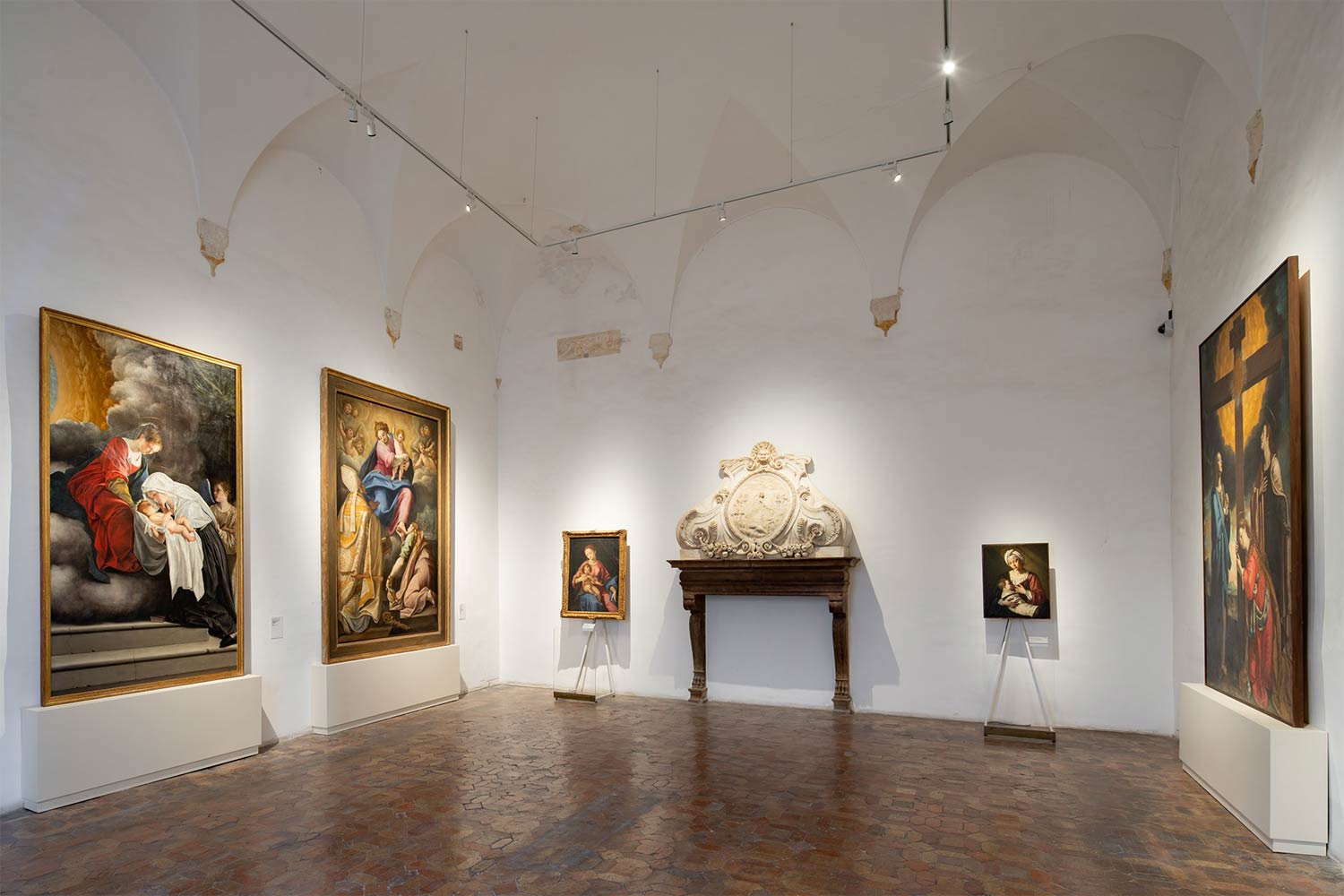
3. Urbino Cathedral
The Cathedral of Santa Maria Assunta, erected by Bishop Blessed Mainardo about 1063, was consecrated to the Assumption of the Virgin Mary. In the 15th century, on the initiative of Federico da Montefeltro, it was rebuilt, probably to a design by Francesco di Giorgio Martini. In the 18th century, designed by Giuseppe Valadier instead, it took on its present neoclassical appearance, with a facade designed by Morigia that contrasts with the surrounding bricks. The bell tower was built at that time, and seven statues of saints stand in front of the facade, including St. Crescentine, patron saint of the city. The interior, with a classical spirit, has three naves, with the high altar adorned by Cristoforo Unterberger’s large painting of Our Lady of the Assumption and bronzes by Camillo Rusconi. Among the most famous paintings are Claudio Ridolfi’s The Translation of the Holy House of Loreto, Federico Barocci ’s Martyrdom of St. Sebastian, and Raphael Motta’sAnnunciation. The dome is decorated with figures of the four evangelists, executed by different painters. Along the left side is a portico from 1621, attributed to Muzio Oddi, which leads to the Oratory of the Grotto, located in the cathedral crypt, with a sculpture by Giovanni Bandini depicting a Dead Christ and Madonna. The cathedral, along with the Albani Museum and the Oratory of the Grotto, forms the centerpiece of Urbino’s ecclesiastical artistic heritage even though it is currently closed for restoration.
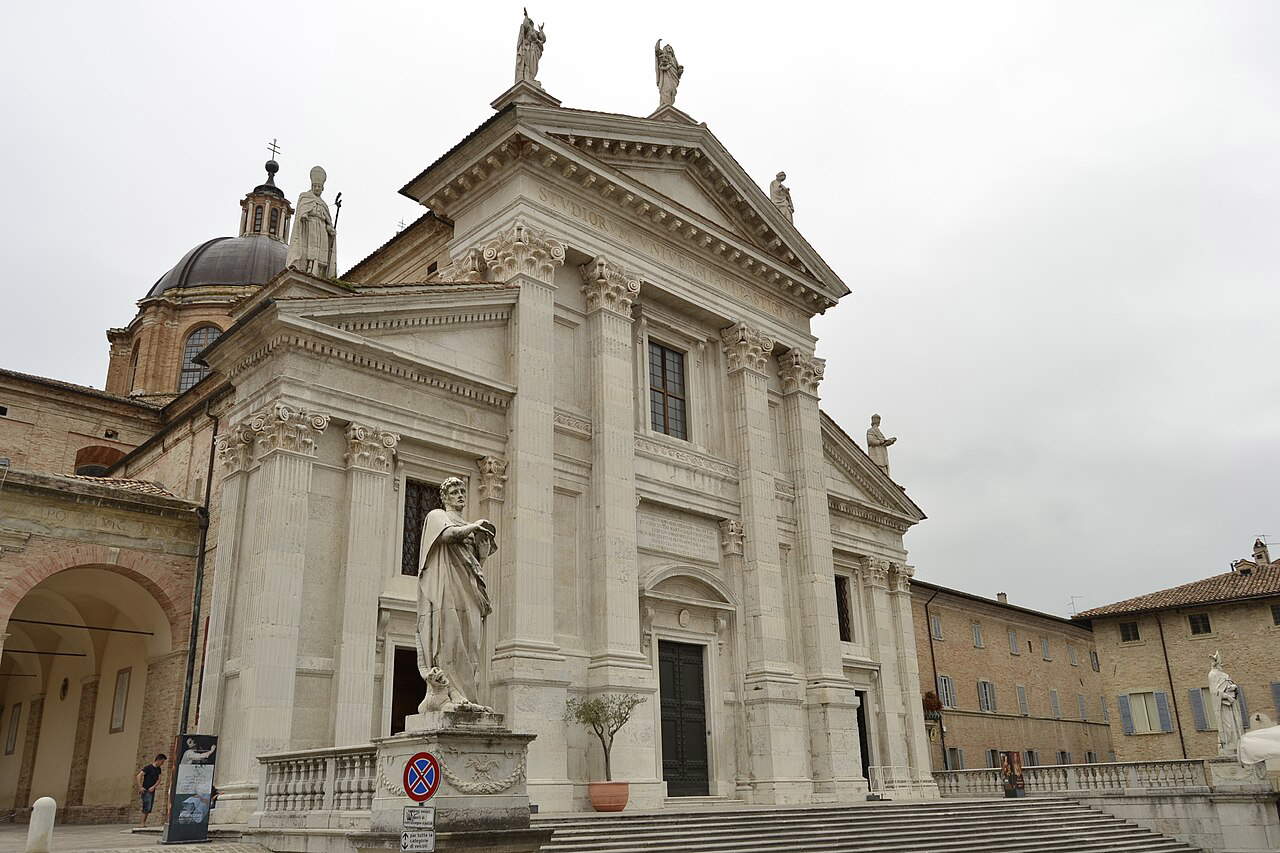
4. Raphael’s Birthplace
The Raphael House, now a museum that can be visited, is where the great artist was born on Good Friday, March 28, 1483, and spent the early years of his artistic training under the guidance of his father, Giovanni Santi, also an accomplished painter. In Urbino, Raphael Sanzio (Urbino, 1483 - Rome, 1520) learned not only artistic techniques but also the importance of philosophy and dignity in his work as a painter, as Carlo Bo pointed out in 1984. After Raphael’s death, the house passed to his heirs, Ciarla and Vagnini, who divided it between them. Later, Urbino architect Muzio Oddi, a neighbor, bought part of the Santi’s former home on September 27, 1635. He restored the building by incorporating it into his mansion and added a beautiful Latin inscription on the facade, along with a couplet by Bembo, still visible today. In 1873, the Raphael Academy acquired the house thanks to a public subscription and the contribution of John Morris Moore, a London nobleman, who made it his home and jealously guarded it, enriching it over time with numerous works of art, thanks to the generous collaboration of private individuals and public institutions. On display inside the Raphael House are paintings, sculptures, ceramics, wooden furnishings and more, some of which are closely related to Raphael, such as copies of his paintings, sketches for his monument and tributes from other artists. Other objects document Urbino’s rich artistic, civil and religious history, while some testify to the myth that surrounded the figure of Raphael in various eras.
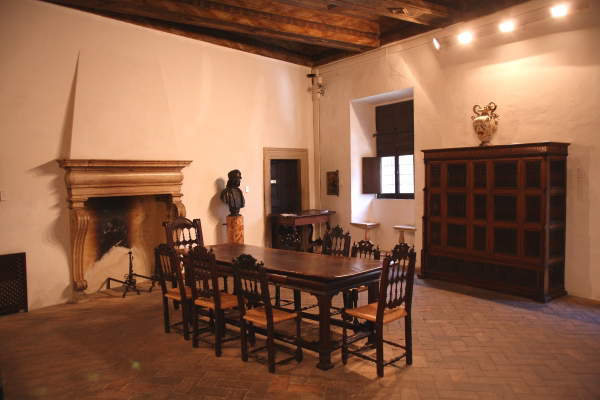
5. The historic center
Urbino stands in the hills of the Marche region overlooking the Adriatic Sea, inland from Pesaro. In the 15th century, under the patronage of Federico di Montefeltro and his son Guidobaldo, the city experienced a cultural golden age, transforming itself from a simple medieval village into a splendid princely court, an attraction for Italian and foreign artists and scholars. Personalities such as Piero della Francesca, Leon Battista Alberti, Paolo Uccello, Baldassarre Castiglione, and Pietro Bembo frequented its ducal court, which exerted a considerable influence throughout Europe. In this same court, artists such as Bramante and Raphael received their early training. The historic center of Urbino, enclosed by rampart walls, stretches for just over a square kilometer, characterized by two main street axes converging in the main square, and an intricate network of narrow streets, alleys, palaces and churches, set in a unique landscape. The intense atmosphere and opportunities offered by the Urbino court between the 15th and 16th centuries fueled the myth of Urbino as an ideal Renaissance city, a supreme example of Italian courts. Not surprisingly, The Ideal City, a famous painting exhibited in the Galleria Nazionale delle Marche, symbolizes the Renaissance and the greatness of Urbino.
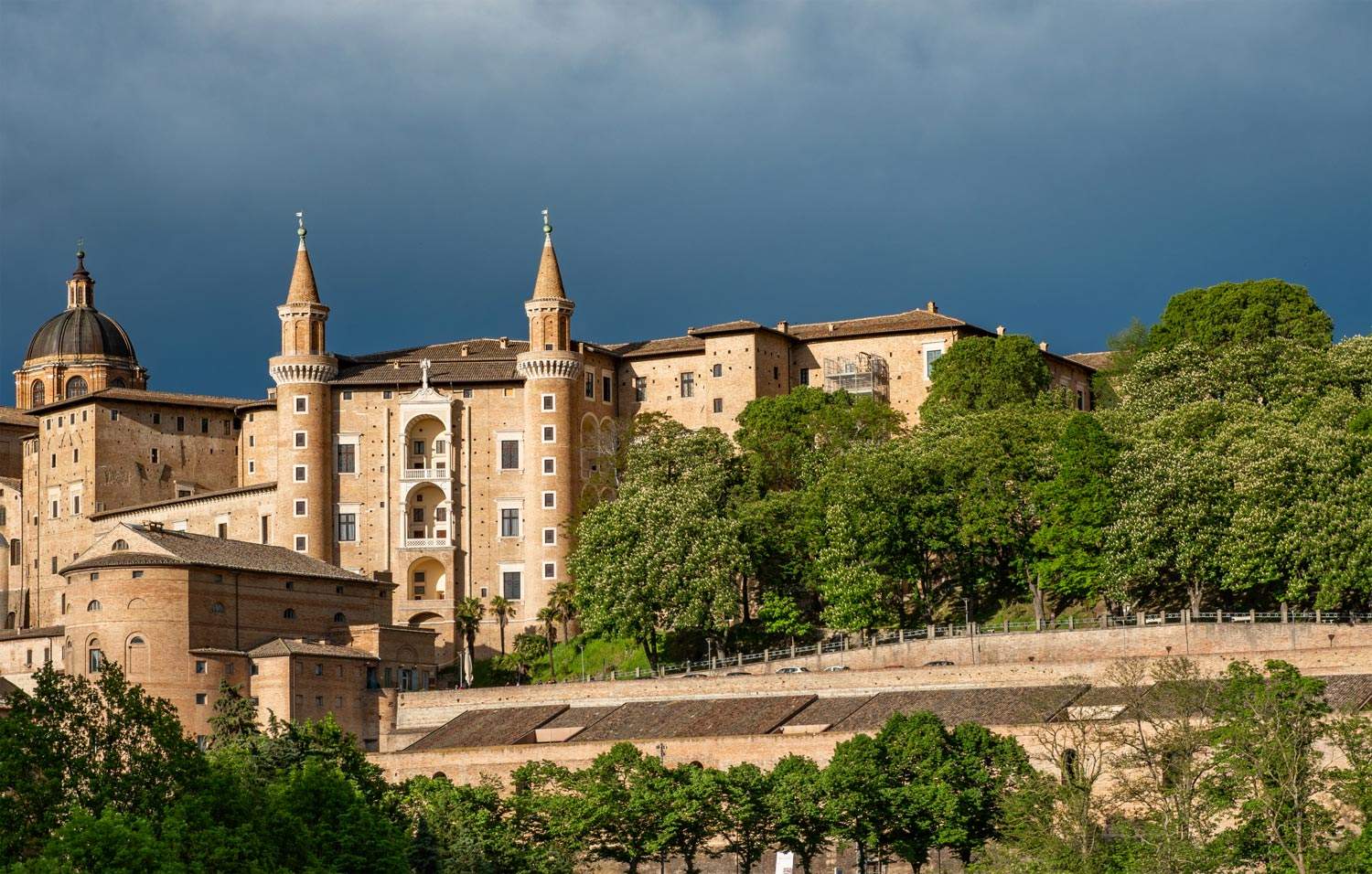
6. Oratory of St. John the Baptist and Oratory of St. Joseph
The Oratory of San Giovanni represents one of the most successful achievements of International Gothic in the region. Home to the Confraternity of the same name, it retains its original structure with a wooden ceiling in the shape of a ship’s hull, while the facade, restored in 1900, is the work of Urbino architect Diomede Catalucci. The frescoes inside are the work of the Salimbeni brothers, along with other artists such as Arcangelo di Cola da Camerino and Gentile da Fabriano, leading figures of the late Gothic period in the region. The cycle of frescoes is considered the most complete work of the Settempedan artists: along the right wall are scenes illustrating the life of St. John the Baptist; on the apse stands out a large Crucifixion dated 1416; on the left wall is Our Lady of Humility. In the Stories of St. John the Baptist, painted on the right wall, the narrative appears calmer and more relaxed. The characters, elegantly dressed and adorned with fanciful hats and sumptuous robes, along with the attention to detail and tastefulness in the accurate depiction of elements drawn from real life, reflect a wholly personal approach to late Gothic. Artistic quality remains consistently high and reaches levels of virtuosity in the paintings of the angels featured in the Baptism of Christ, with brightly colored wings decorated with mother-of-pearl appliqués, again emphasizing the prized nature of panel paintings over wall works. Not far away, the Oratory of San Giuseppe is also worth a visit to admire Federico Brandani’s spectacular 16th-century nativity scene.
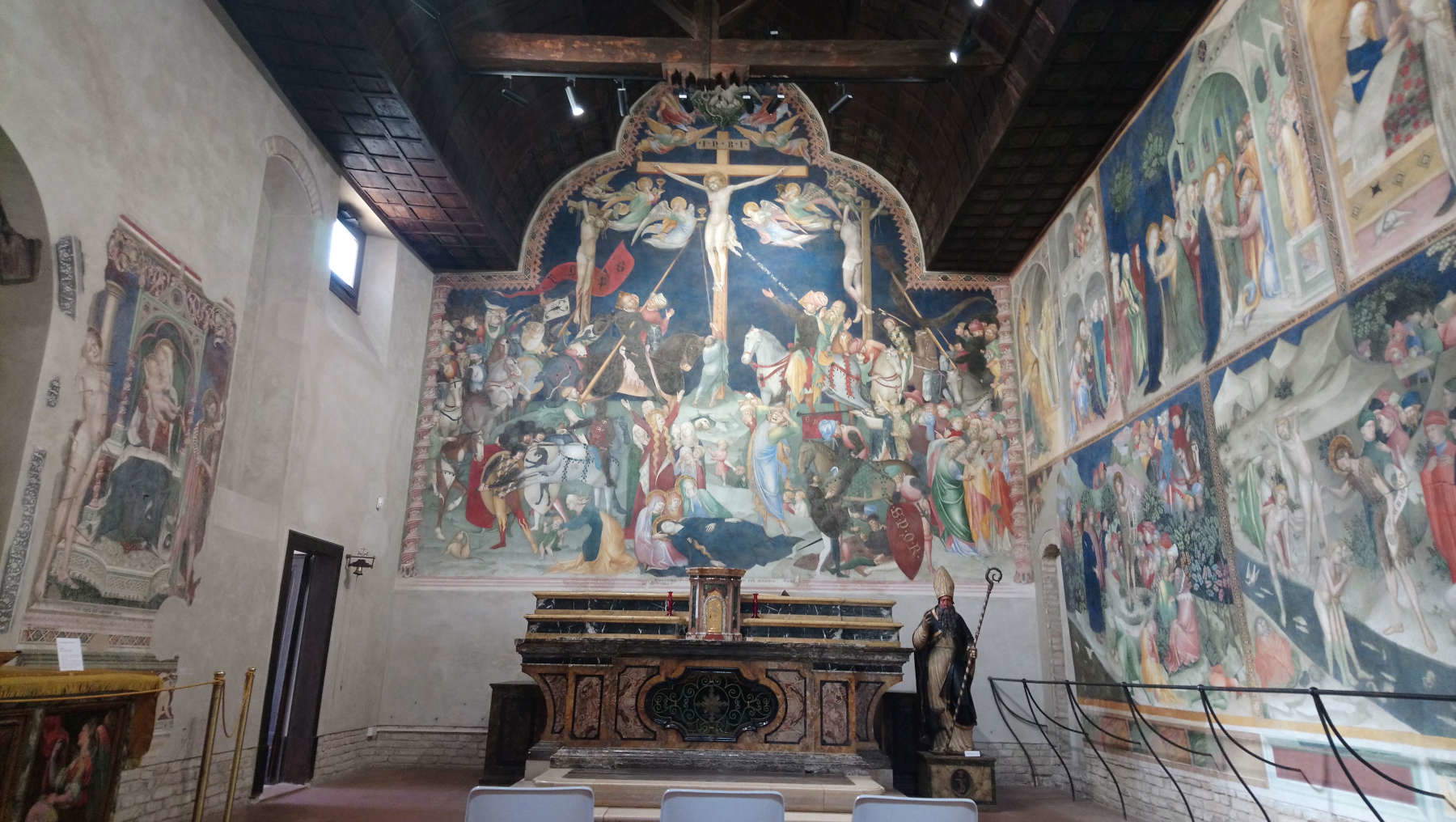
7. Urbino University’s Museum of Plaster Casts.
Urbino’s Museo dei G essi houses a valuable nucleus of plaster casts, mainly from the historical period (18th-19th centuries), acquired by theMarche Institute of Fine Arts soon after its founding in Urbino in 1861 and still owned by the Scuola del Libro-Liceo Artistico, heir to the 19th-century institution. The transfer of the plaster casts to Palazzo Albani began in 1974 thanks to a far-sighted agreement between the parties involved (Institute of Archaeology of the Athenaeum, School Management, Superintendent of Fine Arts); the first museum display was inaugurated in 1988, followed by a second in 2012, after the renovation of the building. The casts, enhanced by the contrast with the brick masonry of the rooms that house them, offer an evocative representation of the most famous sculptures of the Greek and Roman worlds, found since the 15th century in Italy and then in Greece, now preserved in the main museums of Europe such as: the Vatican Museums, Capitolini, Uffizi, MANN in Naples, Louvre, British Museum, Hermitage. The works, an expression of the ideal canon of classicism, continue to exert a strong visual impact on contemporary figurative language, both artistic and popular. The museum is affiliated with the Association Internationale pour la Conservation et la Promotion du Moulages (A.I.C.P.M.).
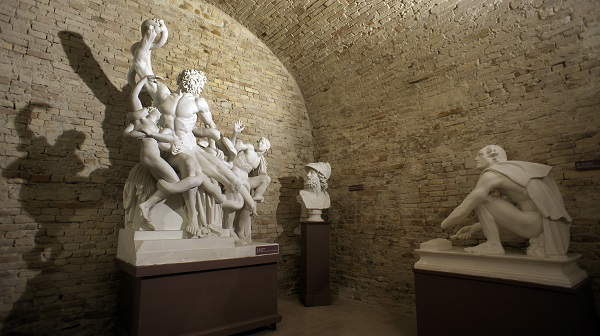
8. Albornoz Fortress
The Albornoz Fortress, also known as Rocca Albornóz, is a fortified structure erected on the highest point of Monte di S. Sergio in Urbino. In fact, its elevated position offers a privileged panoramic view of Urbino and the surrounding landscape, giving it great historical and scenic interest. It is traditionally named after Cardinal Albornoz, although some studies suggest that it may have been built by his successor, Spanish Cardinal Grimoard. Built in the second half of the 14th century for defensive purposes, it replaced the pre-existing fortress, which was deemed inadequate for the city of Urbino. Over the centuries it underwent several destructions and reconstructions; in the 16th century it was connected to the Rovere walls, and in 1673 it was ceded to the Discalced Carmelite Fathers, whose convent, now home to the Academy of Fine Arts, is nearby. During the Napoleonic era in 1799 it was renovated for military purposes and then returned to the Carmelites. In the 1960s restoration work was undertaken that revealed ancient archaeological structures. The present structure, made entirely of brick, has a rectangular layout with two semicircular towers and ramparts. Since 1975 the space in front has been transformed into a large public park dedicated to the Resistance.
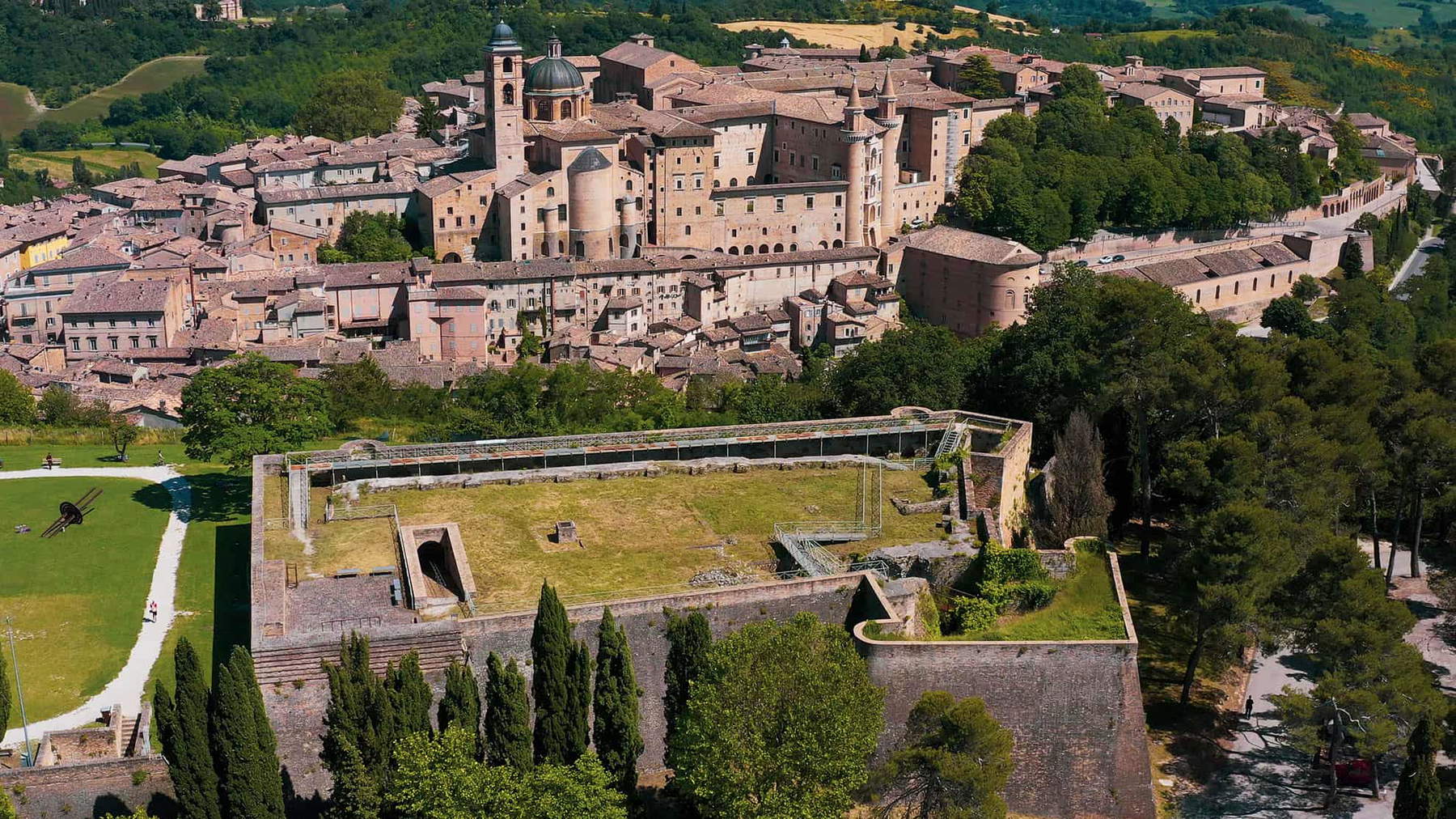
9. Diocesan Museum “Albani”
The itinerary through the artistic heritage of the Archdiocese of Urbino-Urbania-Sant’Angelo in Vado is named after the Albani family, in honor of the patronage activity carried out by Pope Clement XI (1700-1721), who contributed greatly to the enrichment of the “cathedral treasure” on display for scholars. Since 1964, the Episcopal Palace has housed a constantly expanding museum, enriched by recent archaeological discoveries in the region, presenting a new layout. It houses a wide range of church furnishings, dating from the 13th century to the present day: illuminated codices, chalices, reliquaries, majolica, porcelain, amber, gold, silver, crystals, ivory pastorals and liturgical vestments woven with precious metals. Among the extraordinary pieces are the brass lectern from the library of Federico da Montefeltro, Duke of Urbino, and the cast bronze candelabrum by Francesco di Giorgio Martini. Numerous detached frescoes testify to the spread of International Gothic, while the pictorial works dated from the 14th to the 19th centuries represent the most important schools, such as Giovanni Santi’s school of Mannerism, and leading artistic personalities such as Federico Barocci (St. Jerome Penitent; Ecstasy of the Blessed Michelina) and Federico Zuccari (Christ at the Column), who left an indelible mark on local and international artistic history. The imposing Neoclassical-style Cathedral, designed at the end of the 18th century by architect Giuseppe Valadier, together with the Albani Museum and the Oratory of the Grotto, now used as an exhibition space, represent the centerpiece of the ecclesiastical artistic heritage of the city of Urbino.
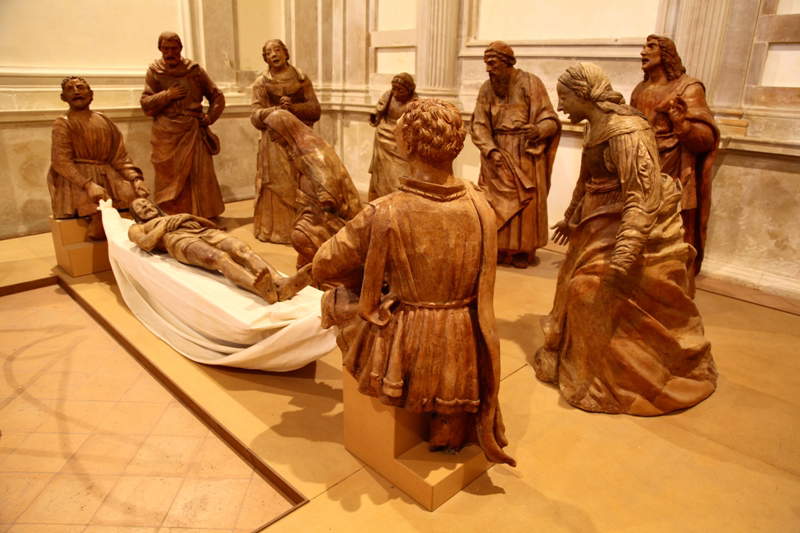
10. Cabinet of Physics: Urbino Museum of Science and Technology
The Urbino Museum of Science and Technology is a museum institution affiliated with the Department of Pure and Applied Sciences (DiSPeA) of the University of Urbino Carlo Bo and is part of the Sistema Museale d’Ateneo (SMAUrb). Located in the heart of Urbino’s historic center, in the 18th-century Palazzo degli Scolopi, the museum has roots dating back to the “Public Academies of Experimental Physics” held in the late 18th century. Although its history as a university facility is relatively recent, dating from 1988 according to an academic resolution, the Physics Cabinet is considered the oldest scientific institution at the University of Urbino. The museum is mainly organized in the vast “Alessandro Serpieri” hall, which houses one of the most significant university collections of historical-scientific instrumentation in Italy. This collection represents an exceptional legacy of equipment used for teaching and research in the field of physics since the late 18th century at the University of Urbino. Displaying a selection of more than 700 scientific instruments, some of them of considerable value, the museum offers the public a unique opportunity to explore the evolution of the physical sciences over the centuries. Many of these instruments have been the subject of extensive archival research and scientific-historical studies, which have enabled us to understand not only their role in the local area, but also their significance nationally and internationally. In addition, the Museum also presents material reconstructions of some of the scientific and mechanical instruments found in the famous inlays of Duke Federico da Montefeltro’s Studiolo, further enriching the understanding and appreciation of the link between science and art in the Renaissance context.
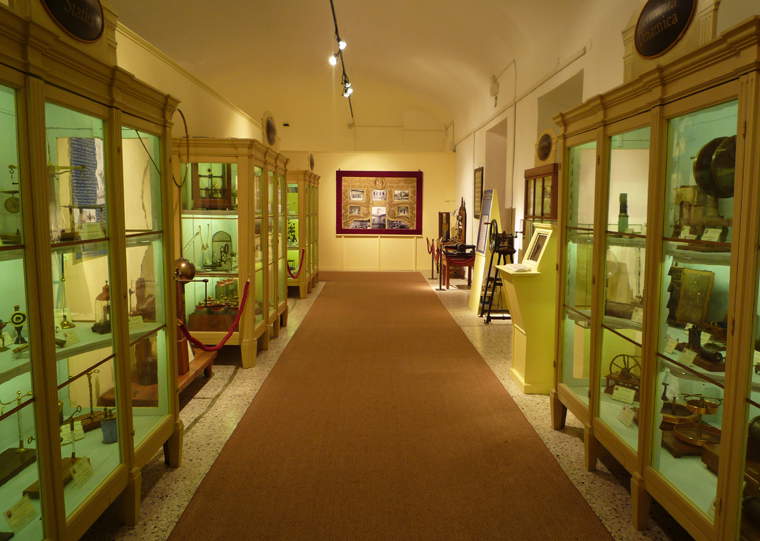
 |
| Urbino, what to see: the 10 places to visit in the city of the Renaissance |
Warning: the translation into English of the original Italian article was created using automatic tools. We undertake to review all articles, but we do not guarantee the total absence of inaccuracies in the translation due to the program. You can find the original by clicking on the ITA button. If you find any mistake,please contact us.


























